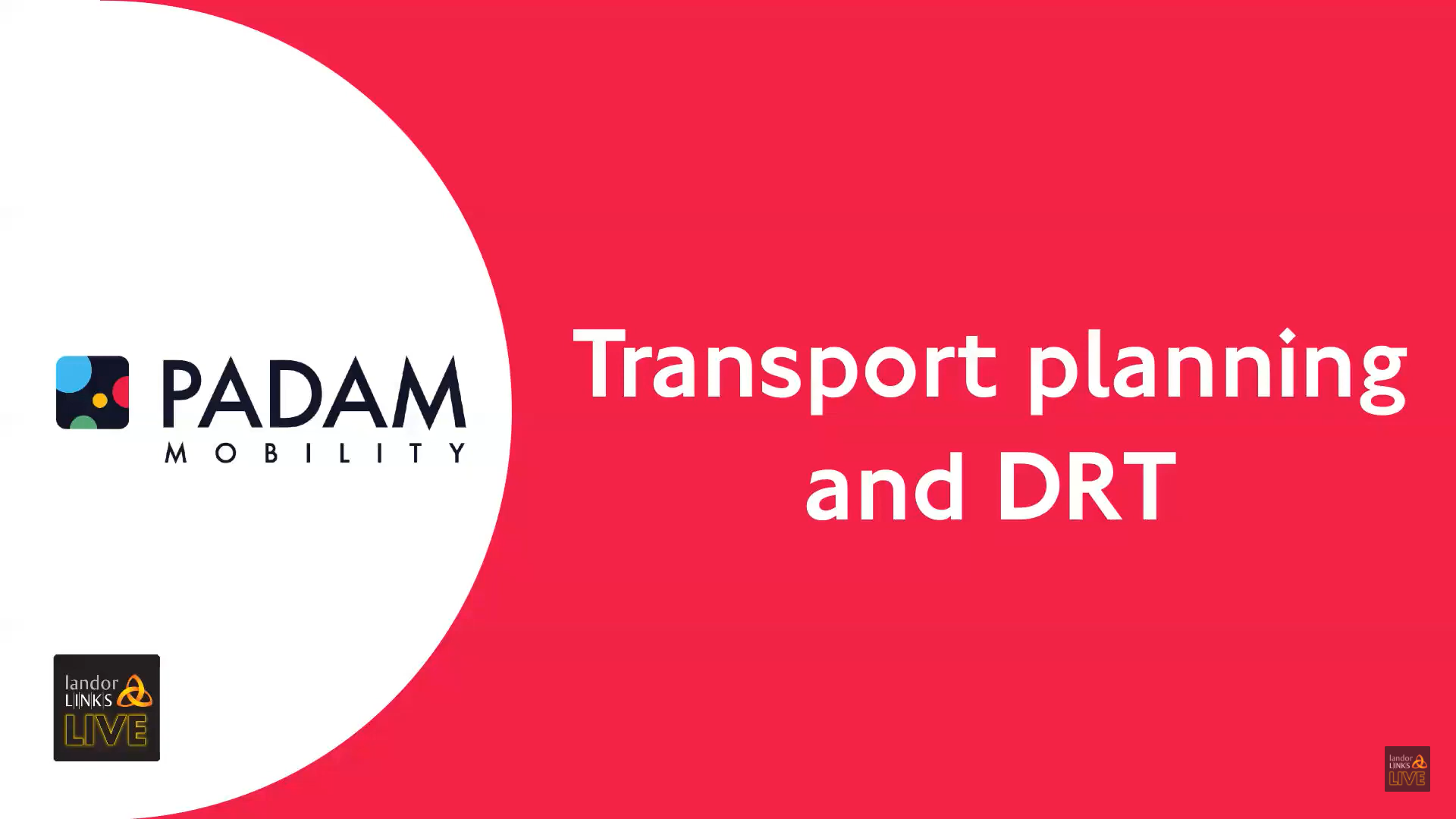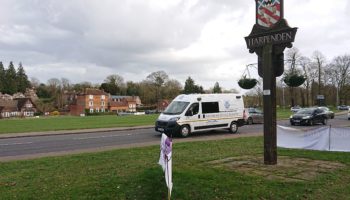Demand-Responsive Transport (DRT) aims to reach people where access to the public transport network is scarce or non-existent, for example in outlying or very rural areas. In fact, the idea of providing people with transportation on demand is not new. However, digitalised on-demand transport optimises the resources used, chooses more efficient routes and operates in such a way that as many people as possible are served at the same time. The concept of DRT is undoubtedly revolutionising the public transport offer, yet it requires careful planning and management. Each area has different characteristics, including its geographical setting, as well as population density, and mobility habits of the citizens, among others.
To illustrate how Padam Mobility works in setting up DRT services as well as providing insights into the (technical) options available to the Transport Consulting team to model on-demand transport, we hosted a webinar together with Landor Links. Chaired by Chris Hillcoat, mobility expert at KPMG, Xuefei Wang, Head of Transport Consulting, and Jack Holland, Head of Business Development, Northern Europe, exchanged in-depth views from theory and practice.
The interest in the webinar was huge. The audience could ask their questions to the panellists in advance or during the webinar. However, 90 minutes was hardly enough to answer all questions in detail. Therefore, we summarise the most frequently asked questions in the following article. Your question is not included or you would like to contact Xuefei or Jack about another topic? – You can reach them at xuefei@padam.io or jack@padam.io.
-
When you model a DRT service, what are the most important contextual questions?
When we model a DRT service, we always aim to fill gaps in the existing public transport offer. This can also mean that a DRT service complements an already fixed line at certain times of the day or that the line is transformed into a DRT service when demand is low, for example at off-peak times.
There are also various contextual aspects that we include in our analysis: Demographics (Who are potential users and what are their needs?), Geography (What are the points of interest in the area? Are there remote areas?, etc.), Economics (Are there industrial sites in the area? Does it make sense to set up transport for employees?), Mobility (What is the modal split in the area? What other mobility providers are present? How do locals usually get around?) and Policy (Is there a local mobility plan? What funds are available for mobility measures?).
All these aspects can shed light on what kind of DRT services people in an area need and influence the modelling of the service: Use case, service design, size of the fleet, costs, number of potential users, etc.
-
Do you have guides on the minimum and maximum populations, trip densities etc. which support a successful DRT service?
Rural services covering vast areas with a free-floating design are likely to have a vehicle occupancy rate of 2 – 3 passengers per hour (at maturity).
Peri-urban services with quite densely populated areas are likely to have occupancy rates of 3 – 5 passengers per hour with a free-floating design. It could be possible to have 6+ in certain service designs if the ingredients are right – such as feeder or virtual lines to a popular transport hub or workplace in peak times.
Minimum population – DRT can cover extremely rural areas, but high subsidies would have to be considered.
Maximum population – In European urban areas with strong bus networks and other public transport, DRT is unlikely to be needed or have a positive effect on congested roads. Here, the focus should be on mass public transport.
-
What are some of the characteristics of rural areas in relation to DRT? Do these characteristics make it easier or harder to operate?
In very rural areas, the distance between destinations is greater, so bundling can be less efficient than in suburban areas. In this case, feeder services in combination with free-floating can be a good service concept, and attempts should also be made to combine D2D-Dial-a-Ride with DRT from bus stop to bus stop.
In addition, deploying EVs is a big challenge in rural areas. Minibuses are a real challenge for battery capacity as they do not have a large footprint for battery capacity, unlike full sizes buses.
There may also be signal problems with the internet, which can disrupt operations. One solution could be using a multi-sim onboard router that picks up different internet providers. Another solution is to print the itinerary for the day as a PDF file so that the driver can use it as a reference, but this would only list the pre-booked passengers, which means less flexibility for cancellations and bookings on that day.
-
What are some of the common misunderstandings about DRT you see in tenders from local and regional authorities?
DRT services with only one vehicle can cover a large area, but can also only reach a very small number of passengers and are therefore often insufficient for residents.
In the UK, most DRTs focus on the free-floating service as a one-size-fits-all service solution. However, from a commercial point of view, other service concepts often involve lower subsidies – semi-flexible, virtual and feeder services can complement free-floating at peak times by targeting demand in specific areas.
Compared to the US, France and Scandinavian countries, we are not yet as advanced in integrating DRT with other modes of transport, such as dial-a-ride, door-to-school, taxi, etc. However, such integration would help to reduce the overall cost of implementation.
Also, pricing in tenders is often based on a trip-per-vehicle model. However, for larger projects, per-trip models may work much better.
-
How can DRT contribute to accessibility and inclusion?
Studies suggest that lack of access to transport puts people at a much greater risk of social isolation. This can in turn lead to high levels of funding needed for healthcare, lack of work, and lack of access to vital goods and services. DRT and dial-a-ride (plus community transport) are essential for serving these areas.
Transport for the North estimates that 3.3 million people in the North of England, or 21.3% of the population, live in areas in which there is a relatively high risk of social exclusion because of issues with the transport system. These areas are widely distributed across the North but are particularly concentrated in former manufacturing and mining communities, in coastal areas, and in smaller towns and cities. The research tells us that high levels of car dependency are the key driver of TRSE (transport-related social exclusion) in the North. This has been exacerbated by declining bus service provision – reducing the travel choices for the most vulnerable people in our communities
-
How does DRT interact with other public transport modes, individually and in a MaaS platform? Can it create efficiencies for bus companies?
One of our most important principles is the integration of DRT into the existing transport network. Non-competition is a very effective tool for this, ensuring that DRT services do not cannibalise fixed bus services. The non-competition feature allows users to be directed to the existing fixed-route service instead of offering a DRT ride.
MaaS is an important concept to integrate DRT as a first and last-mile solution to connect people to existing services. In doing so, feeder services, for example, can effectively take people from their desired stop to key nodes, such as train stations.
-
How do you create a DRT proposition which fills the gap in general transport provision and doesn’t detract from fixed route services whilst also being easy for customers to understand?
Padam Mobility has recently launched a new feature that allows displaying alternative fixed-line services and redirecting users directly to these services. In this way, we achieve that DRT services do not compete with the existing fixed bus line network and thus become counterproductive.
-
Do you have examples of how to get integration between DRT and mainline bus services and the railway network?
Yes, we can use bus and railway timetables in the back office. This schedules the DRT service to meet the timetable (e.g. 5 minutes before). Our best use case for this is the Greater Paris region. We operate 125 vehicles that serve more than 60 metro stations. This generates 700,000 trips each year that connect people to the metro or intercity train.
We also operate another scheme in Strasbourg using 40 electric minibuses which expands the tram network into the rural areas surrounding the line terminus.
-
Scheme economics have always been a challenge for this type of scheme. How would you go about making the best case possible in any given situation?
We believe that DRT funding should be looked at across the silos of funding, not solely on DRT-specific funding. This should look at existing Community Transport funding, dial-a-ride funding, home-to-school and Section 106 Grant Funding to create a long-term funding plan for DRT.
This article could might interest you as well: Transport planning and DRT




